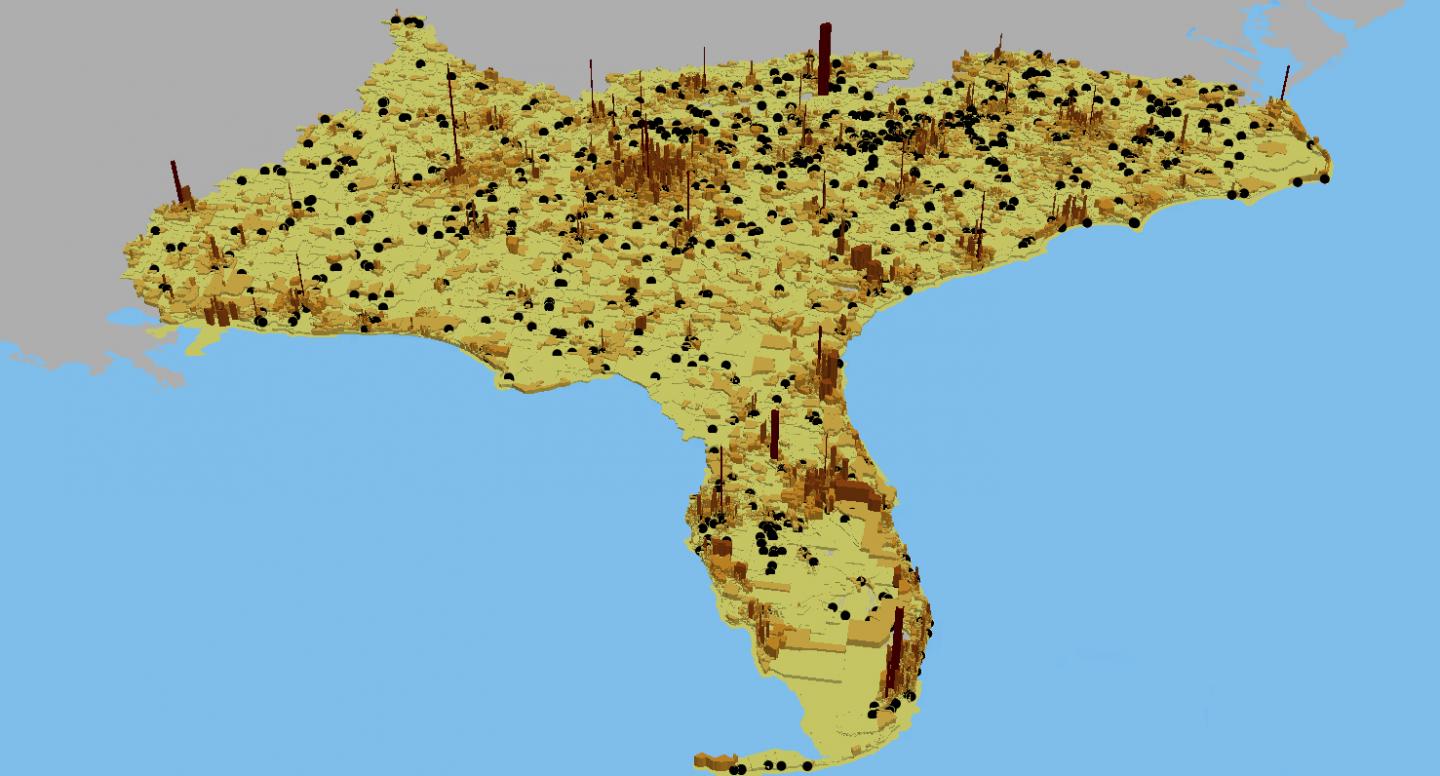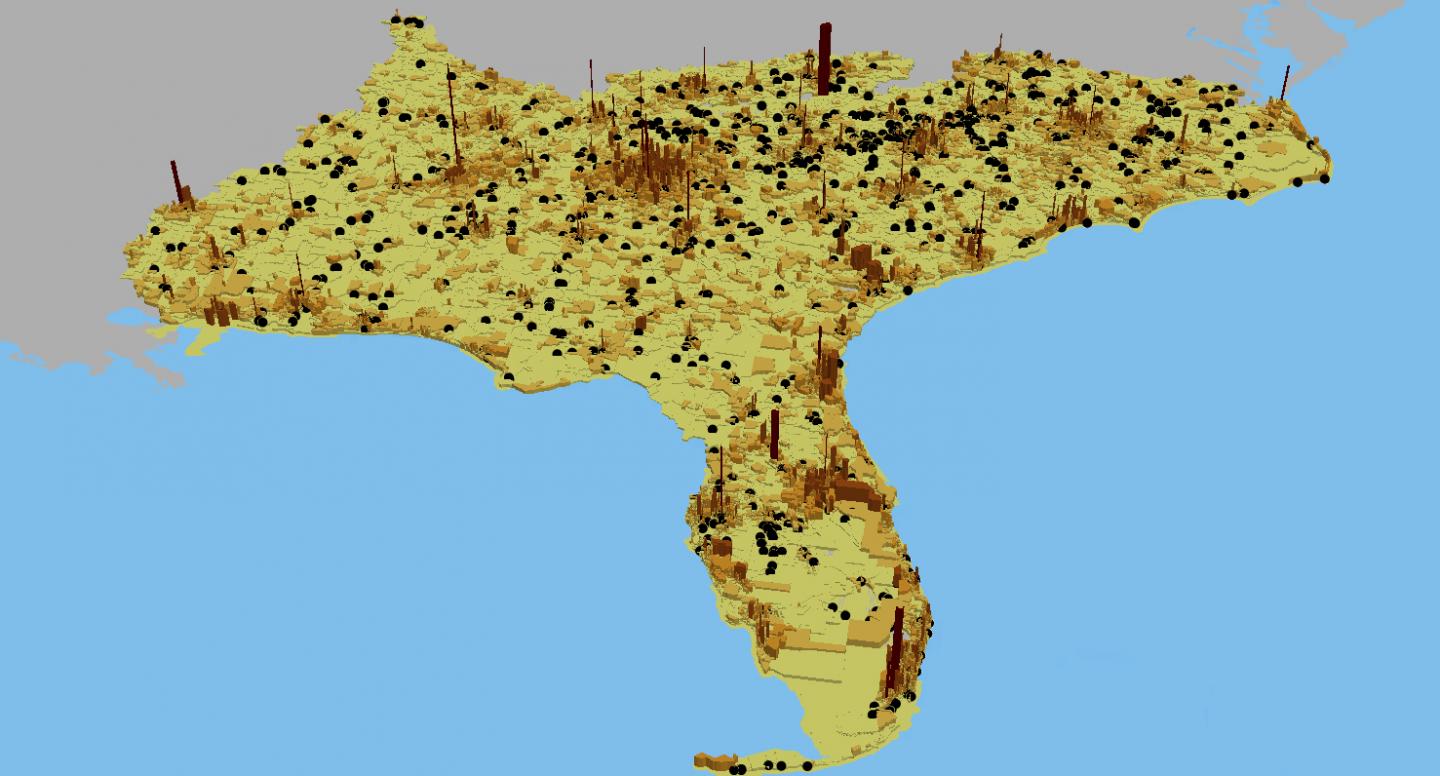
Credit: Ryan McManamay/Oak Ridge National Laboratory, US Dept. of Energy
OAK RIDGE, Tenn., Aug. 23, 2017 – New mapping methods developed by researchers at the Department of Energy's Oak Ridge National Laboratory can help urban planners minimize the environmental impacts of cities' water and energy demands on surrounding stream ecologies.
In an analysis published in Proceedings of the National Academy of Sciences, an ORNL-led team used high-resolution geospatial modeling to quantify the effects of land, energy, and water infrastructures on the nation's rivers and streams.
Using streamflow data from the U.S. Geological Survey, the researchers mapped changes to natural hydrology to assess how infrastructure development and competition over water resources affects the environment at a national scale. Their data-driven approach sheds light on the extent to which water resources and aquatic species are affected by urban infrastructures and could help cities curb their burden on regional ecosystems.
The results indicate that urban land transformation and electricity production together affect seven percent of U.S. streams, which influence habitats for more than 60 percent of all North American freshwater fish, mussel, and crayfish species.
"When you consider that most of these streams include big rivers and their major tributaries with abundant species, the environmental impacts are staggering," said lead author Ryan McManamay, an aquatic ecologist with ORNL's Environmental Sciences Division and Urban Dynamics Institute. The study calculated effects on 1,223 fish, mussel, and crayfish species. At least 260 of these are already locally extinct, with many of the remaining classified as endangered.
Additionally, the researchers conducted case studies on five U.S. cities, Atlanta; Knoxville, Tennessee; Phoenix and Tucson, Arizona; and Las Vegas by creating region-specific models to characterize geographical variables and isolate the cities' land-energy-water footprints from the surrounding landscape.
"Cities have overlapping impacts on the environment, and we want to understand how much energy a single city consumes or how its land cover and electricity production contribute to the overall picture," McManamay said.
In the five cities, urban land transformations negatively affected more stream length overall than any other factor considered, including electricity production. The introduction of roads, buildings, and other impervious surfaces alters the natural water cycle, displaces water supplies for downstream communities and can threaten the loss of rich and diverse aquatic species.
"Urban land transformation and electricity production are important issues for cities because their impacts will grow as cities continue to develop their infrastructures," said ORNL co-author and Urban Dynamics Institute Director Budhendra Bhaduri.
The analysis revealed that ecosystem impacts were not directly proportional to population size, indicating that larger cities do not necessarily have a bigger impact on aquatic life. The authors emphasize the importance of cooperations among cities to develop local policies and better manage their influences upon regional ecosystems because many land, energy, and water infrastructures are controlled by local governments and utilities.
"Both the source and solution to global environmental challenges may lie in the hands of cities. Unfortunately, the changes we discuss are highly transformative, not cheap," McManamay said. "Our goal here is to give cities a way to look at the big picture, so to speak, and to generate metrics that will help them move toward more environmentally sound policies as they continue to develop."
###
This research was funded by ORNL's Laboratory Directed Research and Development Program. The journal article is published as "US cities can manage national hydrology and biodiversity using local infrastructure policy." Co-authors include ORNL's Ryan McManamay, Sujithkumar Surendran Nair, Christopher DeRolph, April Morton, Robert Stewart, Matthew Troia, and Budhendra Bhaduri; Northern Arizona University's Benjamin Ruddell; and the University of Tennessee's Liem Tran and Hyun Kim.
ORNL is managed by UT-Battelle for the DOE Office of Science. The Office of Science is the single largest supporter of basic research in the physical sciences in the United States and is working to address some of the most pressing challenges of our time. For more information, please visit http://science.energy.gov/.
Media Contact
Ashley Huff
[email protected]
865-241-6451
@ORNL
http://www.ornl.gov





